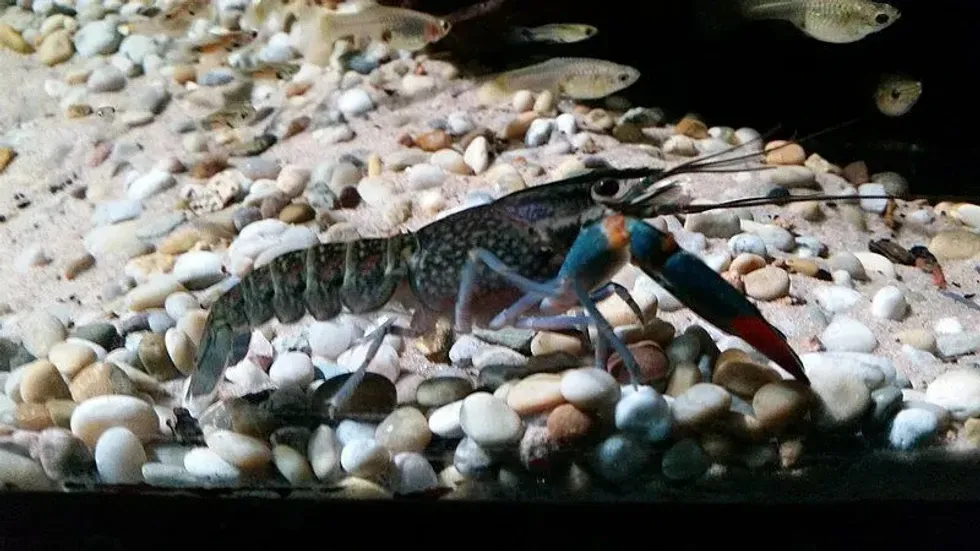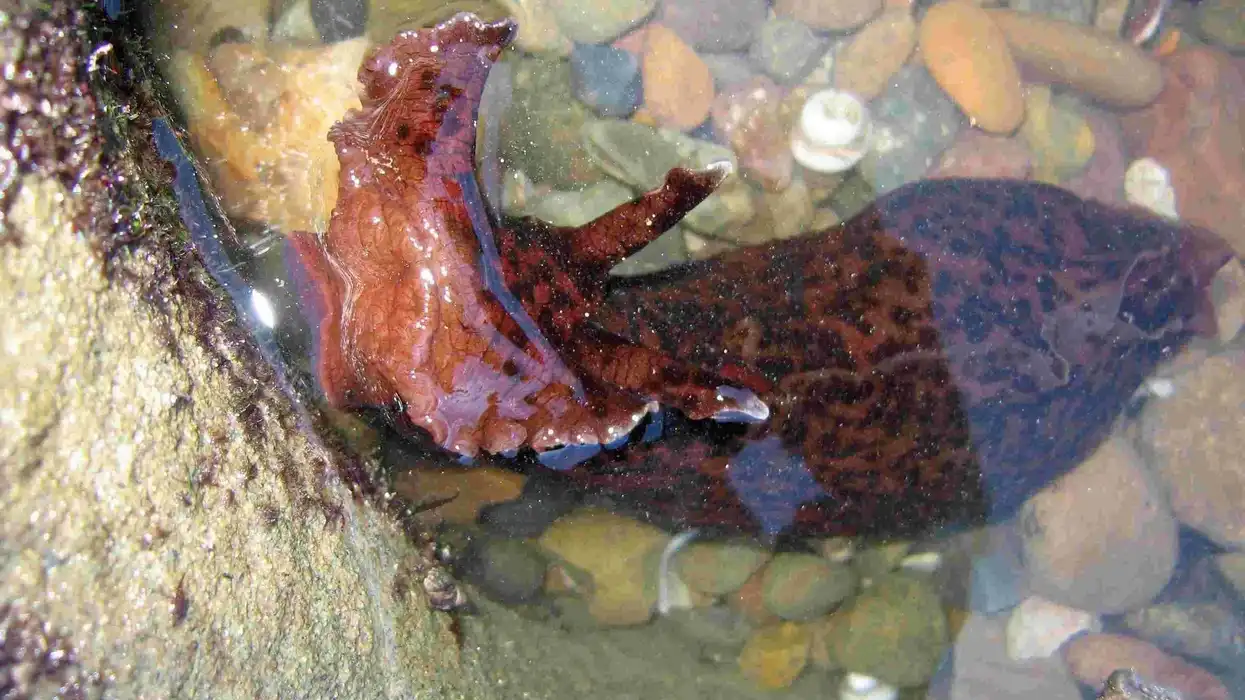The blue crayfish is the most common type of crayfish found in Florida. While many people might not think of them as much more than just tiny bugs swimming around their tank or pond, they are actually quite remarkable creatures with fascinating features!
Unlike most crustaceans, the blue crayfish has no claws on its pinchers.
Instead, it relies on a hard-shelled tail to defend itself against predators and other potential threats in life.
These fishes have a dark brown or red shell with white and orange tips on their claws, spines along each side of their body, and two pairs of antennae that stick out from the top center part (head) just behind where the eyes would be if you were able to see them.
There are many different species but only about 12 populations live exclusively in Florida.
The Procambarus alleni is a freshwater crustacean that has been seen as an invasive species in many different areas. These fishes are distinctively blue with chevron markings on their carapaces and have five pairs of legs plus two claws for gnawing food.
This particular creature can be found at the base of plants waiting to ambush prey from below!
The blue crayfish is one of the most delicious and popular types. They have a lot to offer too!
For instance, they can be made into gumbo or used in étouffée recipes as well as for salads – you name it... maybe even your next dinner!
In addition to this tasty meal option, crayfish tails also make great party food served on ice with dipping sauces like cocktail sauce (made from ketchup), horseradish cream sauce (mustard-based), or mayonnaise-based remoulade.
Though they are primarily freshwater creatures, these small crustaceans will occasionally venture into saltwater for short periods of time if necessary. They can survive up to two weeks away from freshwater before needing a drink again!
If you're interested in getting to know the Florida crayfish, read on! For more relatable content, check out these mantis shrimp facts and ghost shrimp facts for kids.
Florida Crayfish Interesting Facts
What type of animal is a Florida crayfish?
The electric blue crayfish (Procambarus alleni) species is a type of fish that has a wide distribution in Florida.
What class of animal does a Florida crayfish belong to?
The electric blue fish belongs to the class Malacostraca like shrimps, and order Decapoda.
How many Florida crayfish are there in the world?
No one knows for sure, but some estimates say there are at least 200 trillion in the world.
Where does a Florida crayfish live?
A blue crayfish (Procambarus alleni) is a freshwater crustacean that is native to the southeastern United States, especially Florida. They have been spotted as far north and west as California in their habitat!
What is a Florida crayfish's habitat?
The electric blue crayfish live in freshwater and saltwater.
They can be found at the bottom of rivers, lakes, streams, or other water bodies they think might have food to eat. The blue crayfishes are a type of edible crustacean that is commonly sold as seafood!
These little crawlers also like to hang out in their natural habitat either on land near plants where they wait for smaller fish or insects who will come by for their next meal before gobbling them up whole - they're fast for their size!
Who do Florida crayfish live with?
The electric blue crayfish (Procambarus alleni) species can be found living with other animals, including fish and eels who they scavenge food from as well.
How long does a Florida crayfish live?
The electric blue crayfish (Procambarus alleni) species are freshwater crustaceans that live an average lifespan of about three years. They eat plants and invertebrates, while their primary predators include various birds such as night herons and large fish species like yellow basses.
How do they reproduce?
Blue crayfish (Procambarus alleni) species are aquatic creatures that can be found in freshwater. Blue crays reproduce by laying eggs as females shedding their egg sacks and fertilizing them externally with sperm from males who have been waiting nearby to mate, or the male has just passed over her during mating season.
What is their conservation status?
The electric blue crayfish (Procambarus alleni) has the IUCN conservation status of Least Concern.
Florida Crayfish Fun Facts
What do Florida crayfish look like?
The bright colors found in many animals are very rare among crustaceans but the blue crayfish presents an exception to this rule. Blue crayfish have bright eyes which can stand out from afar due to their eye color being an electric shade of cobalt blue!
You may also notice they're shaped like spiny lobsters but not as big or bulky around the thorax region, so you'll need to be careful when handling them because there's less protection for your fingers!
How cute are they?
They are very cute and adorable, with slimy skin and appropriate pet size.
How do they communicate?
Blue crayfish are one-of-a-kind, and not just because they're the only freshwater species in North America! Blue crabs have an even weirder trait: communication via claw clacking (or should it be called 'clawing' since you use your claws?). This also happens when fighting for territory or mates but really who can blame them for their size?
How big is a Florida crayfish?
These blue crayfish are the second largest freshwater invertebrate in size, reaching a length of 4-5 in (10-12 cm).
How fast can a Florida crayfish swim?
A blue crayfish can swim at speeds of up to 3 mph (6-10 kph); some say they could even go as fast as 8 mph (15-20 kph)!
How much does a Florida crayfish weigh?
A blue crayfish is only found in an aquarium and its size is not much and its weight can range between 0.1 lb (16-20 g)
What are the male and female names of the species?
Both male and female wild species of this order go by the name blue crayfish and do not have any sex-specific names whatsoever!
What would you call a baby Florida crayfish?
These cute little babies are known as blue crayfish babies!
What do they eat?
The blue crayfish is an aquatic crustacean that lives in the water. They eat small fish and dead shrimp, but other food includes plant material like algae.
Are they dangerous?
There are not many things cuter than a wild blue crayfish! It is not dangerous at all!
In fact, these fish are so cute that an aquarium uses them as their main attraction. Kids love to watch these exotic critters crawl around in an attempt to find food while you eat your popcorn and drink lemonade near the tank's glass wall.
Would they make a good pet?
Give your child a new pet range today! These crayfishes are known to be one of the most docile freshwater invertebrates there are. They're not aggressive at all and they make perfect pets for kids as well as adults who want an easy-going creature in their life.
Did you know...
As its name might imply, blue crayfish is a popular seafood dish on any menu across the world. Don't believe us? Try for yourself!
Blue crayfish are common in freshwater aquariums. Do you know how to spot them?
They're easy to identify when they have their colors on, but what if the water is murky or cloudy and it's hard for people to see anything at all? The best way is by feeling around with your hands because blue crayfishes will feel rougher than brown ones. That'll help a lot!
How many eggs do Florida crayfish lay?
These crayfish can lay up to 100-300 eggs per batch every time when it reproduces each mating season.
What is the difference between crayfish and crawfish?
Crawfishes have a hard exoskeleton that protects them against their environment as well as any prey trying to escape into its mouth; whereas crayfish have an endoskeleton which means if you touch them with your bare hands without wearing gloves (which is recommended) then they may feel like squishy rubber balls!
Here at Kidadl, we have carefully created lots of interesting family-friendly animal facts for everyone to discover! Learn more about some other fish from our wolffish facts and spiny dogfish facts pages.
You can even occupy yourself at home by coloring in one of our free printable snapper coloring pages.









